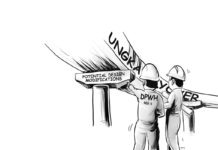
[av_one_full first min_height=” vertical_alignment=” space=” custom_margin=” margin=’0px’ padding=’0px’ border=” border_color=” radius=’0px’ background_color=” src=” background_position=’top left’ background_repeat=’no-repeat’ animation=”]
[av_heading heading=’URBAN FARMER ‘ tag=’h3′ style=’blockquote modern-quote’ size=” subheading_active=’subheading_below’ subheading_size=’15’ padding=’10’ color=” custom_font=”]
BY JULIO P. YAP JR.
[/av_heading]
[av_textblock size=” font_color=” color=”]
Good agricultural practices can reduce pests and diseases
APPLYING Good Agricultural Practices (GAP) can reduce the infestation of pests and diseases of Lakatan and Cardaba bananas.
This came out in a study entitled “Enhanced productivity of Lakatan and Saba/Cardaba in Region 12,”particularly in North Cotabato, Sultan Kudarat, and Maguindanao.
It was realized through the collaboration of the University of Southern Mindanao, Sultan Kudarat State University, and Cotabato City State Polytechnic College.
Lakatan and Cardaba are usually affected by banana bunchy top virus (BBTV), Fusarium wilt, sigatoka leaf spot, banana freckles, and Moko disease.
The impact of these diseases is severe for smallhold farms that do not have the capability to manage the said diseases.
To curb these diseases, the study identified 24 demo trials for Lakatan and 26 for Cardaba in Region 12.
The recommended GAP that were applied include fertilizer application based on soil analysis, desuckering, deleafing, debelling, fruit bagging, and replanting of missing hills, among others.
Sigatoka leaf spot, which is caused by Mycosphaerella fijiensis Morelet, is a fungal disease that causes the banana leaves to turn black and wither.
With GAP, the highest reduction of sigatoka leaf spot in Lakatan was seen in Maguindanao at 95 percent, followed by Cotabato and Sultan Kudarat with 80.33 percent and 64.77 percent, respectively.
Without GAP, reduction of the disease for Maguindanao, Cotabato, and Sultan Kudarat was recorded at 91.57 percent, 68.09 percent, and 40.02 percent, respectively.
BBTV is the most destructive virus of banana in the country with no known cure. It is carried and spread by aphids.
GAP also reduced the incidence of BBTV in Lakatan. The highest percentage reduction was seen in Cotabato at 98.75 percent compared with 93.04 percent without intervention.
BBTV incidence in Cardaba also decreased, with the highest percent reduction observed in Cotabao at 98.38 percent, followed by Maguindanao at 93.33 percent, and Sultan Kudarat at 57.33 percent.
GAP was also applied at a farm in President Roxas town, North Cotabato, where Moko disease infected 41.48 percent of the plant population.
With the intervention applied, only 25.93 percent incidence of the disease was recorded.
Moko is a deadly disease of banana caused by the bacteria Ralstonia solanacearum. It prevents proper growth of the banana plant and eventually dies within a short time.
Significant reduction of banana freckles in Cardaba was recorded in the three provinces of Region 12.
With GAP intervention, the incidence of banana freckles was reduced by 83.90 percent compared with the 50.20 percent reduction by using farmer’s practice.
Banana freckles disease causes large and small spots on leaves and the fruit.
With GAP, Maguindanao observed the highest increase in yield of Lakatan at 116.21 percent, while Cotabato registered the highest increase in yield of Cardaba at 135.54 percent.
Other than the yield, GAP promoted more productive plants with bigger bunch, bigger hands, and longer fingers.
Banana growers in Region 12who are using the technology can expect a return of investment ranging from 156.31 percent to 437.96 percent for Lakatan, and from 133.69 percent to 164.74 percent for Cardaba. (jaypeeyap@ymail.com/PN)
[/av_textblock]
[/av_one_full]



